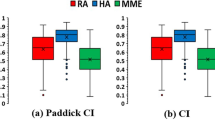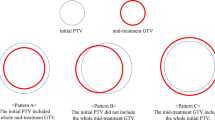Abstract
Purpose/Objective(s)
This study examined changes in the clinical target volume (CTV) and associated clinical implications on a magnetic resonance imaging linear accelerator (MR LINAC) during hypofractionated stereotactic radiotherapy (HSRT) to resected brain metastases. In addition, the suitability of using T2/FLAIR (T2f) sequence to define CTV was explored by assessing contouring variability between gadolinium-enhanced T1 (T1c) and T2f sequences.
Materials/Methods
Fifteen patients treated to either 27.5 or 30 Gy with five fraction HSRT were imaged with T1c and T2f sequences during treatment; T1c was acquired at planning (FxSim), and fraction 3 (Fx3), and T2f was acquired at FxSim and all five fractions. The CTV were contoured on all acquired images. Inter-fraction cavity dynamics and CTV contouring variability were quantified using absolute volume, Dice similarity coefficient (DSC), and Hausdorff distance (HD) metrics.
Results
The median CTV on T1c and T2f sequences at FxSim were 12.0cm3 (range, 1.2–30.1) and 10.2cm3 (range, 2.9–27.9), respectively. At Fx3, the median CTV decreased in both sequences to 9.3cm3 (range, 3.7–25.9) and 8.6cm3 (range, 3.3–22.5), translating to a median % relative reduction of − 11.4% on T1c (p = 0.009) and − 8.4% on T2f (p = 0.032). We observed a median % relative reduction in CTV between T1c and T2f at FxSim of − 6.0% (p = 0.040). The mean DSC was 0.85 ± 0.10, and the mean HD was 5.3 ± 2.7 mm when comparing CTV on T1c and T2f at FxSim.
Conclusion
Statistically significant reductions in cavity CTV was observed during HSRT, supporting the use of MR image guided radiation therapy and treatment adaptation to mitigate toxicity. Significant CTV contouring variability was seen between T1c and T2f sequences.
Trial registration NCT04075305 – August 30, 2019



Similar content being viewed by others
Data Availability
Data will be made available on request to the corresponding author following the institutional ethics committee protocols.
References
Patchell RA, Tibbs PA, Walsh JW, Dempsey RJ, Maruyama Y, Kryscio RJ et al (1990) A randomized trial of surgery in the treatment of single metastases to the brain. N Engl J Med 322(8):494–500
Kocher M, Soffietti R, Abacioglu U, Villa S, Fauchon F, Baumert BG et al (2011) Adjuvant whole-brain radiotherapy versus observation after radiosurgery or surgical resection of one to three cerebral metastases: results of the EORTC 22952–26001 study. J Clin Oncol 29(2):134–141
Chang EL, Wefel JS, Hess KR, Allen PK, Lang FF, Kornguth DG et al (2009) Neurocognition in patients with brain metastases treated with radiosurgery or radiosurgery plus whole-brain irradiation: a randomised controlled trial. Lancet Oncol 10(11):1037–1044
Brown PD, Jaeckle K, Ballman KV, Farace E, Cerhan JH, Anderson SK et al (2016) Effect of radiosurgery alone vs radiosurgery with whole brain radiation therapy on cognitive function in patients with 1 to 3 brain metastases: a randomized clinical trial. JAMA 316(4):401–409
Mahajan A, Ahmed S, McAleer MF, Weinberg JS, Li J, Brown P et al (2017) Post-operative stereotactic radiosurgery versus observation for completely resected brain metastases: a single-centre, randomised, controlled, phase 3 trial. Lancet Oncol 18(8):1040–1048
Brown PD, Ballman KV, Cerhan JH, Anderson SK, Carrero XW, Whitton AC et al (2017) Postoperative stereotactic radiosurgery compared with whole brain radiotherapy for resected metastatic brain disease (NCCTG N107C/CEC.3): a multicentre, randomised, controlled, phase 3 trial. Lancet Oncol 18(8):1049–1060
Soliman H, Myrehaug S, Tseng CL, Ruschin M, Hashmi A, Mainprize T et al (2019) Image-guided, linac-based, surgical cavity-hypofractionated stereotactic radiotherapy in 5 daily fractions for brain metastases. Neurosurgery 85(5):E860–E869
Eitz KA, Lo SS, Soliman H, Sahgal A, Theriault A, Pinkham MB et al (2020) Multi-institutional analysis of prognostic factors and outcomes after hypofractionated stereotactic radiotherapy to the resection cavity in patients with brain metastases. JAMA Oncol 6(12):1901
Soliman H, Ruschin M, Angelov L, Brown PD, Chiang VLS, Kirkpatrick JP et al (2018) Consensus contouring guidelines for postoperative completely resected cavity stereotactic radiosurgery for brain metastases. Int J Radiat Oncol Biol Phys 100(2):436–442
Eaton BR, LaRiviere MJ, Kim S, Prabhu RS, Patel K, Kandula S et al (2015) Hypofractionated radiosurgery has a better safety profile than single fraction radiosurgery for large resected brain metastases. J Neurooncol 123(1):103–111
Specht HM, Kessel KA, Oechsner M, Meyer B, Zimmer C, Combs SE (2016) HFSRT of the resection cavity in patients with brain metastases. Strahlenther Onkol 192(6):368–376
Minniti G, Esposito V, Clarke E, Scaringi C, Lanzetta G, Salvati M et al (2013) Multidose stereotactic radiosurgery (9 Gy x 3) of the postoperative resection cavity for treatment of large brain metastases. Int J Radiat Oncol Biol Phys 86(4):623–629
Teyateeti A, Brown PD, Mahajan A, Laack NN, Pollock BE (2020) Brain metastases resection cavity radio-surgery based on T2-weighted MRI: technique assessment. J Neurooncol 148(1):89–95
Hall WA, Paulson ES, van der Heide UA, Fuller CD, Raaymakers BW, Lagendijk JJW et al (2019) The transformation of radiation oncology using real-time magnetic resonance guidance: A review. Eur J Cancer 122:42–52
de Mol SR, van Otterloo CJP, Blezer ELA, Akhiat H, Brown K, Choudhury A et al (2021) Patterns of Care, tolerability, and safety of the first cohort of patients treated on a novel high-field mr-linac within the momentum study: initial results from a prospective multi-institutional registry. Int J Radiat Oncol Biol Phys 111:867–875
Sneed PK, Mendez J, Vemer-van den Hoek JG, Seymour ZA, Ma L, Molinaro AM et al (2015) Adverse radiation effect after stereotactic radiosurgery for brain metastases: incidence, time course, and risk factors. J Neurosurg 123(2):373–386
Cao Y, Tseng CL, Balter JM, Teng F, Parmar HA, Sahgal A (2017) MR-guided radiation therapy: transformative technology and its role in the central nervous system. Neuro Oncol 19(2):ii16–ii29
Mutic S, Dempsey JF (2014) The ViewRay system: magnetic resonance-guided and controlled radiotherapy. Semin Radiat Oncol 24(3):196–199
Fallone BG (2014) The rotating biplanar linac-magnetic resonance imaging system. Semin Radiat Oncol 24(3):200–202
Alghamdi M, Hasan Y, Ruschin M, Atenafu EG, Myrehaug S, Tseng CL et al (2018) Stereotactic radiosurgery for resected brain metastasis: Cavity dynamics and factors affecting its evolution. J Radiosurg SBRT 5(3):191–200
Scharl S, Kirstein A, Kessel KA, Duma MN, Oechsner M, Straube C et al (2019) Cavity volume changes after surgery of a brain metastasis-consequences for stereotactic radiation therapy. Strahlenther Onkol 195(3):207–217
Atalar B, Choi CY, Harsh GRT, Chang SD, Gibbs IC, Adler JR et al (2013) Cavity volume dynamics after resection of brain metastases and timing of postresection cavity stereotactic radiosurgery. Neurosurgery 72(2):180–185
Jarvis LA, Simmons NE, Bellerive M, Erkmen K, Eskey CJ, Gladstone DJ et al (2012) Tumor bed dynamics after surgical resection of brain metastases: implications for postoperative radiosurgery. Int J Radiat Oncol Biol Phys 84(4):943–948
ClinicalTrials.gov. Single Fraction Stereotactic Radiosurgery Compared With Fractionated Stereotactic Radiosurgery in Treating Patients With Resected Metastatic Brain Disease. NCT04114981. Assessed Nov 2021 [
Wernicke AG, Hirschfeld CB, Smith AW, Taube S, Yondorf MZ, Parashar B et al (2017) Clinical outcomes of large brain metastases treated with neurosurgical resection and intraoperative cesium-131 brachytherapy: results of a prospective trial. Int J Radiat Oncol Biol Phys 98(5):1059–1068
Ahmed S, Hamilton J, Colen R, Schellingerhout D, Vu T, Rao G et al (2014) Change in postsurgical cavity size within the first 30 days correlates with extent of surrounding edema: consequences for postoperative radiosurgery. J Comput Assist Tomogr 38(3):457–460
Faruqi S, Ruschin M, Soliman H, Myrehaug S, Zeng KL, Husain Z et al (2020) Adverse radiation effect after hypofractionated stereotactic radiosurgery in 5 daily fractions for surgical cavities and intact brain metastases. Int J Radiat Oncol Biol Phys 106(4):772–779
Kohutek ZA, Yamada Y, Chan TA, Brennan CW, Tabar V, Gutin PH et al (2015) Long-term risk of radionecrosis and imaging changes after stereotactic radiosurgery for brain metastases. J Neurooncol 125(1):149–156
Milano MT, Grimm J, Niemierko A, Soltys SG, Moiseenko V, Redmond KJ et al (2021) Single- and multifraction stereotactic radiosurgery dose/volume tolerances of the brain. Int J Radiat Oncol Biol Phys 110(1):68–86
Jhaveri J, Chowdhary M, Zhang X, Press RH, Switchenko JM, Ferris MJ et al (2018) Does size matter? Investigating the optimal planning target volume margin for postoperative stereotactic radiosurgery to resected brain metastases. J Neurosurg 130(3):797–803
Blonigen BJ, Steinmetz RD, Levin L, Lamba MA, Warnick RE, Breneman JC (2010) Irradiated volume as a predictor of brain radionecrosis after linear accelerator stereotactic radiosurgery. Int J Radiat Oncol Biol Phys 77(4):996–1001
Funding
The authors did not receive financial support from any organization for the submitted work.
Author information
Authors and Affiliations
Contributions
Concept: HT, HS, JS, Acquisition of data: All authors, Formal Analysis, Interpretation of data: HT, HS, JS, MR, Initial draft, revising draft, final draft: All authors, Project administration: AS, HS, All the authors are in agreement and accountable for all the aspects of the work.
Corresponding author
Ethics declarations
Conflict of interest
Mark Ruschin is a co-inventor/owns intellectual property specific to the image-guidance system on the Gamma Knife Icon outside the submitted work. Hany Soliman has received travel accommodations/expenses and honoraria from Elekta AB outside the submitted work. Arjun Sahgal is an advisor/consultant for AbbVie, Merck, Roche, Varian, Elekta AB, BrainLAB, and VieCure; is a board member of the International Stereotactic Radiosurgery Society; is cochair of the AO Spine Knowledge Forum Tumor; has conducted educational seminars for Elekta AB, Accuray Inc, Varian, BrainLAB, and Medtronic Kyphon; has received research grants from Elekta AB and travel accommodations/expenses from Elekta AB, Varian, and BrainLAB; and is a member of the Elekta MR-Linac Research Consortium, Elekta Spine, Oligometastases, and Linac-based SRS Consortia. Chia-Lin Tseng has received travel accommodations/expenses and honoraria from Elekta AB and belongs to the Elekta MR-Linac Research Consortium. The remaining authors reported no disclosures or conflicts of interest related to submitted work.
Additional information
Publisher's Note
Springer Nature remains neutral with regard to jurisdictional claims in published maps and institutional affiliations.
Rights and permissions
About this article
Cite this article
Tan, H., Stewart, J., Ruschin, M. et al. Inter-fraction dynamics during post-operative 5 fraction cavity hypofractionated stereotactic radiotherapy with a MR LINAC: a prospective serial imaging study. J Neurooncol 156, 569–577 (2022). https://doi.org/10.1007/s11060-021-03938-w
Received:
Accepted:
Published:
Issue Date:
DOI: https://doi.org/10.1007/s11060-021-03938-w




